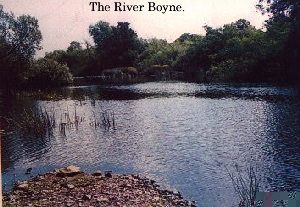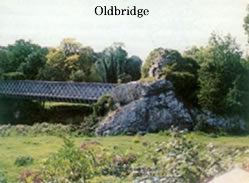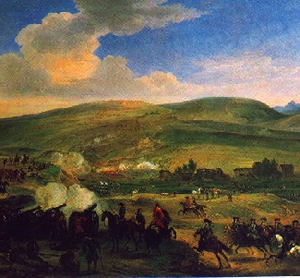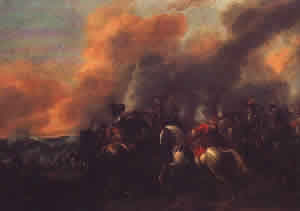The Battle of the Boyne
Having landed at Carrickfergus on 14 June 1690, King William
marched south to engage the Jacobite army along the River
Boyne on 1st July 1690.
The Field. As William advanced the Irish
retreated before him so that by 30 June his army reached the
top of a hill near the southern frontier of County Louth.
In the valley beyond was the River Boyne marking the boundary
of Louth and Meath.  Down
the Boyne at Oldbridge the river could be forded. William
viewed the terrain and thought it suitable for a battle which
should be short and conclusive. Down
the Boyne at Oldbridge the river could be forded. William
viewed the terrain and thought it suitable for a battle which
should be short and conclusive.
The two kings had advantages over one
another. James had the stronger position, but his troops appeared
to be inferior in quality and quantity. He had about 30,000
men of which a third were very good French infantry and equally
fine Irish cavalry.
William had 36,000 men of various nationalities and languages.
The Preparation. When William studied the
enemy across the Boyne he agreed with his generals that they
were not impressive to look at, but added, "They may
be stronger than they look, but weak or strong, I will soon
know all about them." The Irish recognised William and
a marksman fired at him. When it struck the gun holster of
Prince George of Hesse William cried, "The poor prince
is killed." As he spoke a second shot tore his coat,
grazed his shoulder and drew blood. When William slumped over
the Irish thought that he had been killed. His men were shocked
but quickly relieved when he said "There is no harm done,
but the bullet came quite close enough." His injury did
not prevent him spending nineteen hours in the saddle that
day.
Having assured himself that his men were as ready for battle
as he was he advised his officers that he intended to engage
the enemy.
The Battle. The armies began to move at
4 a.m. on 1 July. William ordered his right wing, under the
command of Meinhart Schomberg, a son of the old duke, to march
to the bridge at Slane, a few miles up the river. The troops
were to cross there, and to turn the left flank of the Irish
army. James anticipated the move and dispatched Sir Neill
O'Neill, nephew of Tyrconnell, with a regiment of dragoons
to turn the Williamites back. But when O'Neill received a
mortal wound his men fled to make clear the way for the forces
of King William.
Lauzen, the French commander, feared that William's right
wing would come up at the rear of James' forces, and decided
to march with his French soldiers and Sarsfield's cavalry
in the direction of Slane Bridge. This decision meant that
the fords near Oldbridge were left to be defended only by
the Irish foot soldiers. When the battle was joined they were
easily defeated. Richard Hamilton put himself at the head
of the cavalry and under his command they tried to change
the course of the battle. Fighting desperately in the bed
of the Boyne against Solmes' Blues they drove the Danish brigade
back and successfully attacked the Hugenots.

Duke Schomberg, watching from the Northern bank,
decided that the situation needed a general's intervention
and though not wearing defensive armour he rode into the fray
crying, "Come on, gentlemen, there are your persecutors."
These were his last words, for after being circled by Irish
cavalrymen, when they moved on he was found dead, killed by
two sabre wounds on his head and a bullet in his neck.
King William arrived, where the battle was hottest, in his
presence the tide was turned in his favour.
Lord Macaulay said of William, "One of the peculiarities
of this man, ordinarily so saturnine and reserved, was that
danger acted on him like wine, opened his heart, loosened
his tongue, and took away all appearance of restraint from
his manner. On this memorable day he was seen wherever the
peril was greatest."
On the other hand James, with his reputation as a soldier,
was so concerned for his own safety that he stayed well away
from the heat of battle.
When he realised that he was defeated at the Boyne he deserted
the scene of battle and made for Dublin with a bodyguard commanded
by Sarsfield. He was followed by his troops who had suffered
fewer losses than might have been expected. A reason for that
was that William did not pursue them with the kind of enthusiasm
and energy he had shown in war.
The losses of life at the Battle of the Boyne were much less
than that of any battle of equal importance.
The Result. The Battle of the Boyne was the most famous of
Irish battles, for it represented in the Europe of the day
a signal success for the Grand Alliance against Louis XIV.
The drama of two kings fighting at an Irish river for an
English throne was a sensation in itself. The fact that they
represented the two major power groups in Europe, and were
supported by international armies, gave the Boyne universal
significance.
The flight of James and William's triumphal entry into Dublin
had all the marks of an overwhelming victory.
With William's victory at the Boyne the fate of James was
sealed.
Noted Paintings

The Battle of the Boyne, by Jan Wyck,
National Army Museum, London.

A cavalry skirmish, c.1690, by Jan
Wyck, Ulster Museum, Belfast.
Back to History Home Page
Back to The Williamite
Wars Home Page
|

